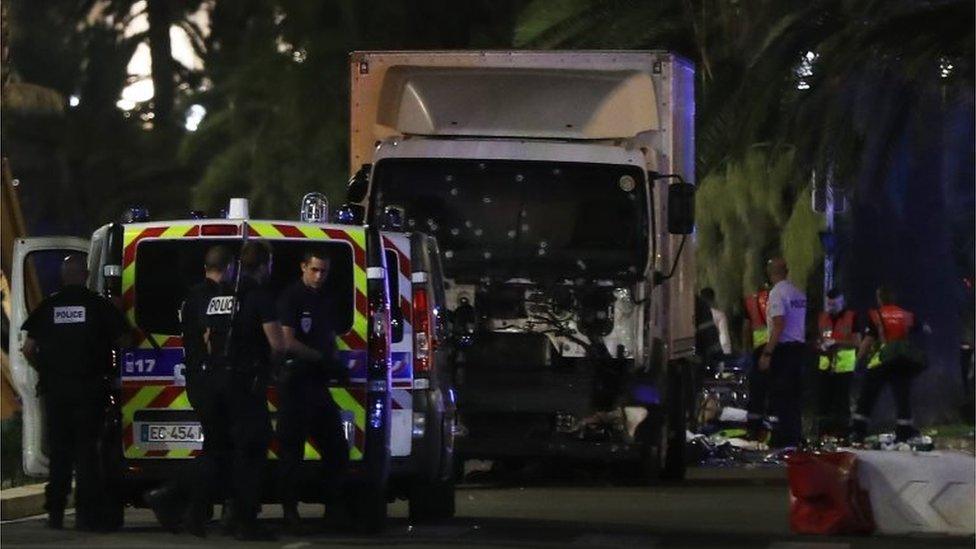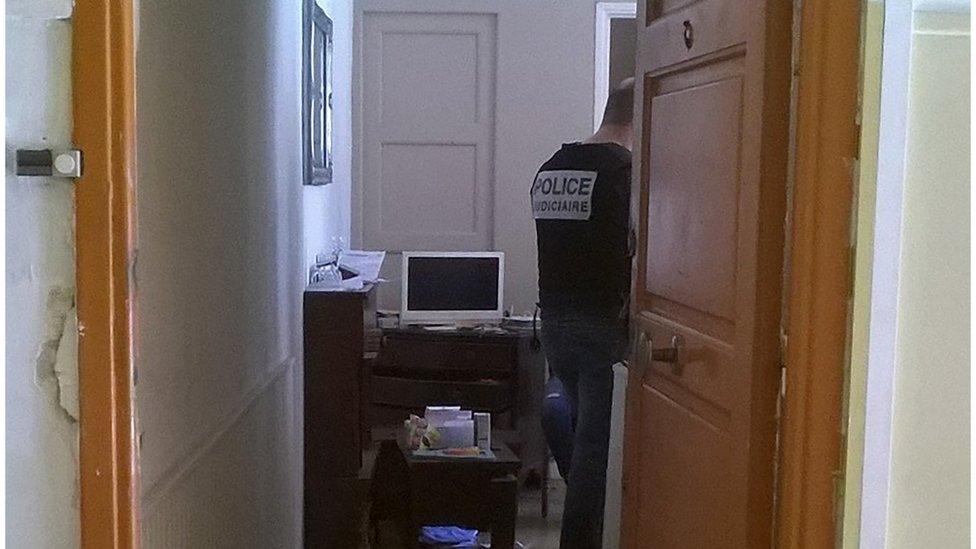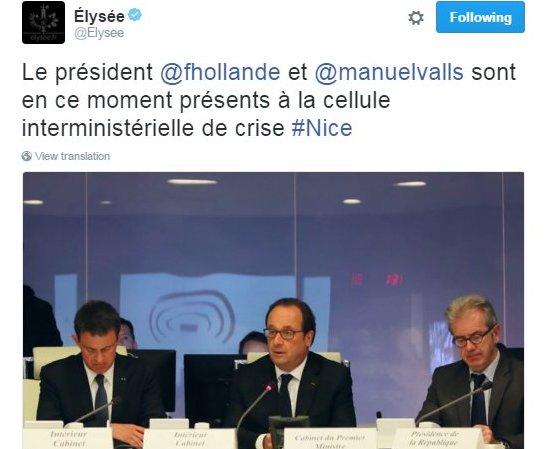Nice attack: What we know about the Bastille Day killings
- Published

The lorry was finally brought to a stop opposite a luxury hotel: police had raked the windscreen with bullets
Dozens of people were killed, including children, when a lorry ploughed into a large crowd watching a fireworks display in Nice to mark the Bastille Day holiday.
The driver also fired shots, before being killed by police. This is what we know about what happened.
Who was the attacker?
The driver of the lorry was identified as Mohamed Lahouaiej-Bouhlel, a 31-year-old Tunisian man.
Paris prosecutor Francois Molins says Lahouaiej-Bouhlel was divorced with three children. His ex-wife was taken into custody along with four other people believed to be linked to him. A flat he lived in near Nice railway station was searched by police.

Police are examining documents taken from a flat in Nice
Lahouaiej-Bouhlel was "totally unknown" to security services, and investigations are continuing into whether he acted alone, Mr Molins said.
Lahouaiej-Bouhlel is said to have hired the lorry from a rental company in Saint-Laurent-du-Var, a town to the west of Nice, on 11 July. He had been due to return it on 13 July.
Police said that, at the time of the attack, Lahouaiej-Bouhlel was in possession of an automatic pistol, bullets, a fake automatic pistol and two replica assault rifles (a Kalashnikov and an M16), an empty grenade. Also in the lorry with him were a driving licence and a bank card.
Who were the victims?
Eighty-six people were killed, all but three of them at the time of the attack. The dead included 10 children and teenagers.
A total of 303 people were taken to hospital for medical treatment. A man who was badly injured in the assault died on 4 August, taking the total number of those killed to 85.
In the hours after the attacks, worried relatives posted images on social media of the missing.
Among the dead was Fatima Charrihi, whose son said she was the first to die.
Another victim, according to reports, was the assistant head of the Nice border police, Jean-Marc Leclerc.
An American 11-year-old boy, Brodie Copeland, and his father, Sean, were also killed. They had been on holiday in Nice.
Three people on a school trip from Germany were unaccounted for.
Who was behind the attack?
French security officials are still assessing whether the driver of a truck was working alone or in a group.
So-called Islamic State later claimed one of its followers carried out the attack.
A news agency linked to the group, Amaq Agency, said: "He did the attack in response to calls to target the citizens of the coalition that is fighting the Islamic State."
Officials said it bore the hallmark of a terrorist organisation.
President Hollande said it was "an attack whose terrorist nature cannot be denied".
Mr Molins said the attack was "in line with the constant calls to kill" from militant Islamist groups, and the investigation would be seek to find out whether Lahouaiej-Bouhlel had ties to Islamist militants.
French Interior Minister Bernard Cazeneuve said Lahouaiej-Bouhlel seemed to have been "radicalised very quickly".
Anti-terrorist prosecutors in Paris have launched an inquiry for murder and attempted murder as part of an organised terrorist strike.
France's DGSI internal security organisation warned of the danger of further attacks from Islamist militants with "booby-trapped vehicles and bombs".
The so-called Islamic State has targeted France on several occasions since January 2015.
Only hours before the Nice attack, President Hollande had announced that France's state of emergency would be removed later this month. After the attack in Nice he announced it was being extended.
What happened on the promenade?
Attack in Nice: Fly-through video of how events unfolded
The terror began a little after 22:30 (20:30 GMT) on 14 July, shortly after thousands of people had watched a firework display on the seafront.
There had been a mood of celebration and the crowd had enjoyed an air force display. Families strolled along the city's renowned Promenade des Anglais.
A large white lorry was seen driving erratically a couple of streets away from the seafront promenade. "He was speeding up, braking, speeding up again and braking again. We thought it was weird," said Laicia Baroi. She described how the lorry then turned on to the promenade heading south-west towards the airport.
But it was not for another half hour before the attack began. A German journalist saw events unfold from a hotel balcony, as the lorry doubled back from the direction of the airport, breaching the barriers erected on the promenade opposite the Lenval children's hospital.
"He was driving really slowly, that's what was astonishing," said Richard Gutjahr, who described seeing the lorry being tailed by a motorcyclist. "The motorcyclist tried to overtake him and even tried opening the lorry driver's door," he told AFP news agency. At that point the motorcyclist fell under the wheels of the lorry.
When two police officers opened fire on the lorry, the driver accelerated and careered at full speed towards the crowd.
The vehicle mounted the kerb then went back on the road, zigzagging for up to 2km (1.25 miles), as the driver deliberately drove into people.
Nice attack: Footage of final gun battle
A local MP spoke of hundreds of people being run over. Others scrambled to safety, on to the beach or into nearby hotels.
"I was opposite the Palais de la Mediterranee [hotel] when I saw a lorry at high speed running over people. I saw it with my own eyes, people tried to stop it," said one witness.
Police finally managed to bring the lorry to a halt near the luxury hotel.
Paris Prosecutor Francois Molins says the driver fired repeatedly on three policemen, who returned fire and pursued him for hundreds of metres.
Mobile phone footage appeared to show the moment the driver was shot.
Images from the scene showed the windscreen and front of the lorry raked with bullets. Interior ministry officials later confirmed that the attacker had been "neutralised".
How have the authorities reacted?
It soon became clear that many people had died, although the full scale of the disaster was unclear. The dead and injured were taken to the local Centre Hospitalier Universitaire de Nice.

The presidency said during the night that the president and prime minister had convened an interministerial crisis meeting
In the area around Nice, the anti-terror alert was raised to its highest level.
President Francois Hollande was flown back to Paris from a visit to Avignon, joining Prime Minister Manuel Valls in a crisis room. Mr Valls declared three days of mourning.
The pair then travelled to Nice, where the interior and health ministers were already involved in crisis meetings with local officials.
Mr Hollande met his defence and security chiefs and cabinet ministers.
Later, Interior Minister Bernard Cazeneuve called on "patriotic citizens" to become reservists to boost security across the country.
He also reiterated a pledge made by Mr Hollande to call up France's current squad of reservists, which total some 12,000 volunteers.